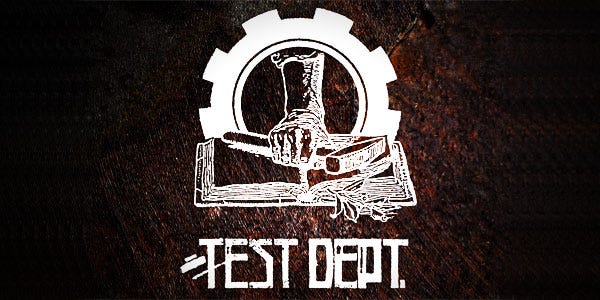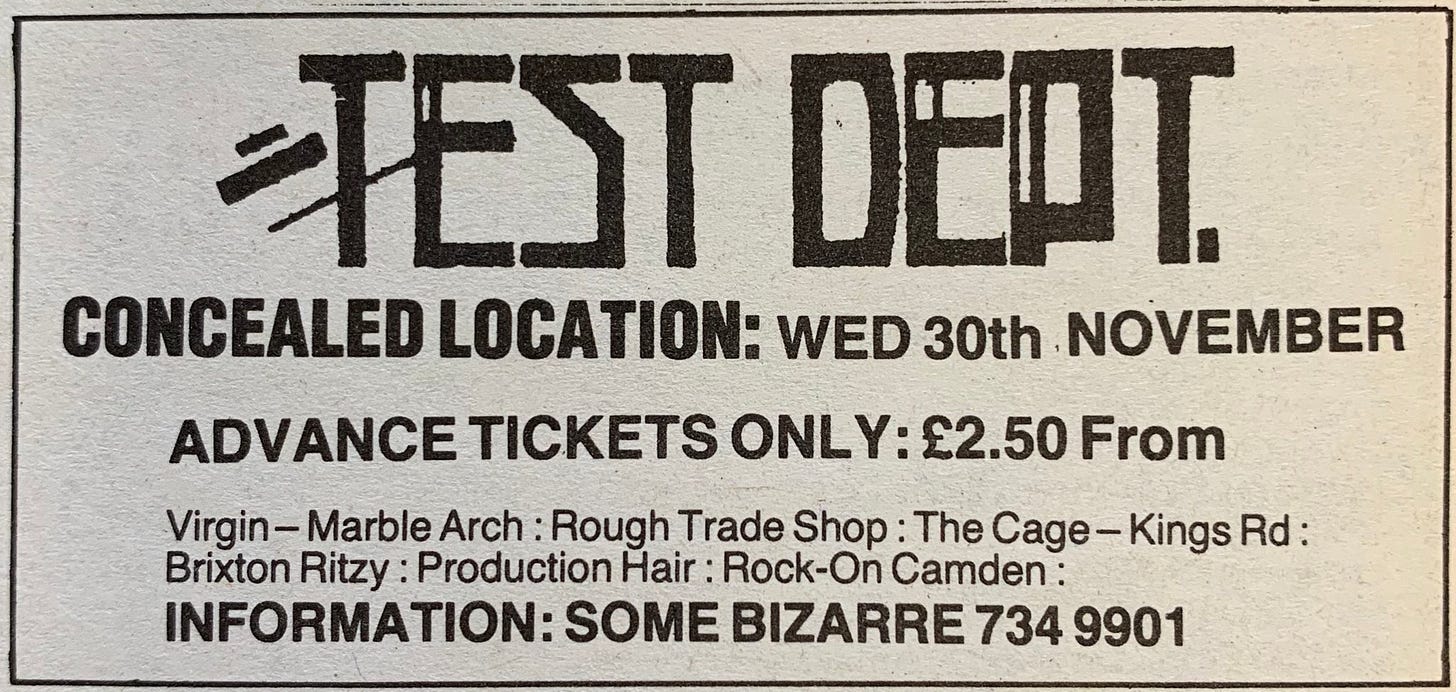The unconventional wonders of Test Dept.
One of the most thought-provoking acts of the 1980s.
Test Dept were an industrial, visually-impactful, political-engaged group, appreciated by the likes of Andrew Weatherall and blessed with two NME front covers. Thinking now about their energy, intensity, terms of reference, creative collaborations, their work during the 1984–1985 miners’ strike, their relationship to Cold War politics and attention to the agents and processes of state control and manipulation, and ambitious immersive shows they performed at industrial sites, it’s a shame their contribution to the 1980s isn’t better known.
The interview that follows was for my fanzine, Debris. It’s never been online before. I met Test Dept during the late Summer of 1986 outside Charing Cross station, just a few months after their fourth studio album The Unacceptable Face of Freedom had been released on the Some Bizzare label.
I was a fan of the group, although I never got to see them play live. They performed at various regular venues like the Leadmill with 23 Skidoo in June 1983. The NME review of that gig by the late Amrik Rai describes their performance; “Using gas cylinders, water tanks, corrugated iron sheets, hammers and crowbars and a bass drum and backing tapes of demented classical choirs, they forge a disciplined set of music, brutal in its touch and expressively aggressive.”
Other elements of their sound included sampling (their sampling of voices, often from radio broadcasts, dropping into the beat-heavy melee of the music was particularly effective). It’s also worth saying that it wasn’t just dance and hip hop acts that found uses for technology like looping and sampling.
In August 1983, Test Dept told interviewer Don Watson about the environment around where they were living in London (New Cross); “South London is basically a haven for scrap heaps. There’s more of them here than in anywhere else in the country. You can see that all of these things have just been slung away to make room for new technology. The old industrial thing is already dead, so what we’re doing its taking its remnants and turning them into something else, something creative”.
In addition to established venues, Test Dept also performed, often with collaborators, at disused factories and other industrial sites, including once or twice at secret locations. At least one was broken up by the police. Again, it wasn’t just the acid house pioneers later in the 1980s that found musical uses for derelict buildings.
Robin Rimbaud (aka Scanner), who went on to become an activist, composer, and sonic adventurer in his own right, described in his diary seeing Test Dept live at Cannon Street Railway Station in June 1983; “They actually played on the platform itself, industrial atmosphere, cold, stark, black clothing everywhere, cropped hair, blinding white lights, painful. Forty minutes of pure metal percussion. Showed videos, Ken Campbell dropping a magnet over a bridge. A brilliant, if brief gig”.
Scanner has also written of them since; “Though many reports focused on the ‘metal-bashing’ aspects of the group, the human voice almost always played a key role. The voice could be heard breathing rhythmically or delivering words in a frenzied brutal style, repetitive, heated and committed. Looped, echoed, intoning charged phrases, ‘one voice, one will’, ‘shockwork,’ ‘efficiency.’ On record and live, a liberal use of radio broadcasts was used inside the soundscapes, which had a profound influence upon my own development and use of found voice and narrative in early Scanner recordings.”
I’m glad Scanner mentions the black clothing and cropped hair in his diary entry. This was a look around at that time, which I was quite attracted to. One issue of Debris featured a full page photo of Russian poet, playwright and visual artist Vladimir Mayakovsky. The era in Russian art and culture Mayakovsky was a part of – which included Constructivism and Futurism – was an influence on the visual side of Test Dept, and their collaborators like film-maker Brett Turnbull who produced visuals for Test Dept’s live events.
On record, the overwhelming percussive beat bangings are slightly tamed but still full of impact, and there’s an intriguing use of samples and found sounds. I guess if you were looking for acts doing similar work you’d cite Neubauten, and Laibach – a sense of being European in the midst of the Cold War, and a response to living through a grim post-industrial time.
The miners’ strike was a traumatic death spasm of Britain’s industrial society. Test Dept marked their support for the miners in several ways, including releasing the Shoulder to Shoulder album; a collaboration with the South Wales Striking Miners Choir. One track on the Shoulder to Shoulder album, called ‘Stout Hearted Men’ (a song made famous by Nelson Eddy in 1940) I used to play very early in evenings at the Hacienda, while the party people took their places under the balcony and around the edges of the dancefloor. My pal, the designer Trevor Johnson - responsible for hundreds of Factory and Haçienda flyers, designs, and artwork - still talks about it to this day. It’s hilarious to think that of all the music I played in twenty thousand hours of DJing at the Haç, Trevor most remembers a marching song written in 1927, sung by a Welsh choir, and championed by Test Dept.
Other features in the issue of Debris alongside Test Dept include a piece about the 1930s social research project Mass Observation, and an interview with the Factory band Kalima. In the fanzine I describe sitting on the train to London with my Walkman listening to Test Dept tapes; including the clanging chorus of percussion, shouting, cut-up voices and panic of ‘Fuck Head’, and the eerie disquiet of voices lifted from Radio Tirana and elsewhere on ‘Comrade Enver Hoxda’.
For their live show at Bishopsbridge Maintenance Depot at Paddington, Easter 1986, Test Dept worked with metal sculptor Malcom Poynter, a dance troupe and choreographer Jacob Marley, words from the radical miner Alan Sutcliffe (Alan’s speech opens the track ‘Shockwork’ on the Shoulder to Shoulder album), and a script by playwright Jonathan Moore.
This epic event in the Maintenance Depot was directed by Teddy Kiendl, the set designed by Tom Dixon, banners were provided by 53rd State Banner Co, a brass section from Loose Tubes jazz orchestra. What would now be called “immersive” soundscapes and visuals were provided by various hands, including Brett Turnbull. Test Dept dubbed the organisation behind this collaboration “The Ministry of Power”. They later described the event as “the first ever ‘rave’ in the UK and a benchmark for large scale site specific work in Britain”.
Back in 1986, for the Debris interview we went to a cafe close to Heaven (a club) and drank tea. I expect it was the café I went to a few times in that part of London, which I have a feeling was in an arcade or under the arches maybe; perhaps someone reading this will remember this particular ‘greasy spoon’ café better than I can. Three of Test Dept met with me that day; Angus Farquhar, Paul Jamrozy, and Graham Cunnington.
They told me of a contact they’d just made with Steve Martland. He was then just thirty years old, a composer who has just had his piece ‘Babi Yar’ performed in America (’Babi Yar’, outside Kiev, is the site of a Nazi massacre of Jews. There’s a poem by Yevtushenko and a piece by Shostakovich about the same place). Factory Records followers will recognise Steve Martland; he was later drafted into the label to help curate and develop classical music releases.
As with other archive interviews I’ve posted on this Substack, the full transcription that follows is only available to paid subscribers. This series includes interviews with the likes of Viv Albertine, Sonic Youth, Robert Forster, and Jamie Reid.




